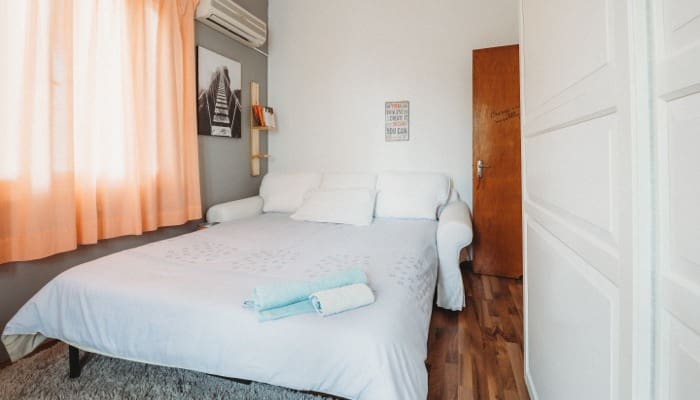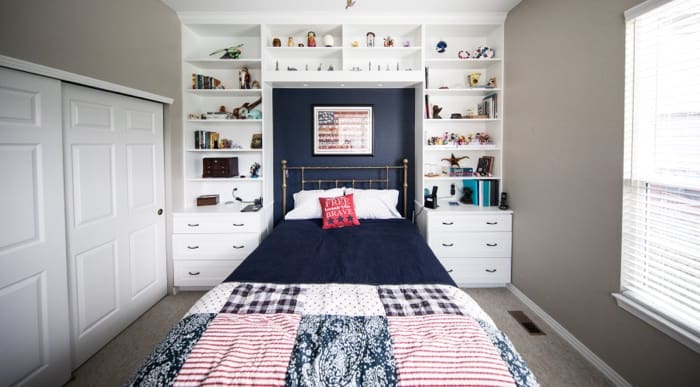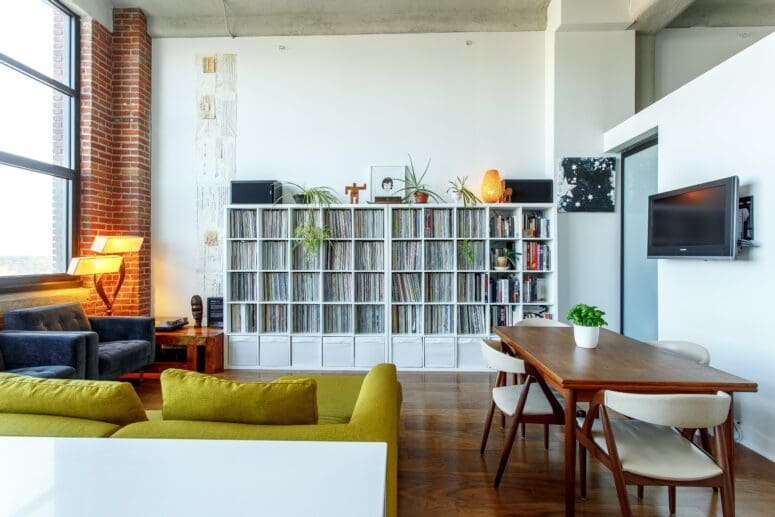Apartment Staging that Sells: 10 Pro Techniques to Get the Best Offer for Your Unit
- Published on
- 7-8 min read
-
 Emma Diehl Contributing AuthorClose
Emma Diehl Contributing AuthorClose Emma Diehl Contributing Author
Emma Diehl Contributing AuthorEmma's work has been featured in Huffington Post, NPR and XOJane. When she's not combing her neighborhood for open houses, she's writing about technology, real estate or data.
In larger markets, the available real estate often includes a more diverse mix of property styles to accommodate limited space and the high cost of living. Top New York City real estate broker Dylan Hoffman sells a lot of apartment units, in fact, which can present a few challenges: How do you make your apartment stand out from one in the building next door, which mirrors yours in size, layout, and price?
It all comes down to presentation. According to data from HomeLight’s Top Agent Insights survey, 80% of agents say that staged homes sell faster. In the apartment resale world, though, if you don’t use staging, you’re dead in the water.
“If one unit is empty or poorly staged and another is smartly outfitted with all the right pieces, the staged apartment will sell immediately, and the other one will sit,” says Hoffman.
Imagine Monica’s apartment from Friends. Now picture it unfurnished. Which one feels more inviting? Not every apartment can pull off purple walls, but certain apartment staging techniques will help you compete and attract a great offer. Here are 10 ideas to get you started.

1. Don’t leave buyers wondering “What will fit?”
Find a way to assure the potential buyers that their king-size bed or beloved antique desk will fit through the building’s elevator or stairwell and into their apartment. Refrain from any elements that might suggest the opposite.
“Using blowup mattresses, cardboard boxes, or other fake bed nonsense will ultimately put fear into the new buyer,” explains interior designer, architect and founder of the Portland-based home staging company Spade and Archer Design Agency Justin Riordan. “They might think it will be impossible to get their bed into their new space and thus they will back out of making an offer on the space.”
Instead, work with your agent to create fact sheets that offer the dimensions of each room as a takeaway at showings. Instead of having potential buyers fret over the size of the bedroom, or pull out their tape measures, do the work for them upfront. Make it easy for buyers by anticipating their questions.
2. Define vague spaces
The goal of staging an apartment is to show buyers how they could comfortably live in a space. That can be a challenge in smaller units or open concept apartments where functional areas like living and dining rooms aren’t designated. Use staging to create those spaces with rugs, furniture, and accents.
Dining rooms can be tricky because you might be dealing with a small eat-in area or just a fraction of your living room space, and your setup needs to be proportional to the rest of the unit.
To get the right number of seats for your dining area, Riordan recommends the following formula:
1. Take the total number of bedrooms your apartment has.
2. Multiply that number by two. Then, add two additional seats for guests.
With that calculation:
- A two-bedroom apartment needs 6 seats (paired with a 60-inch round or square table, 72-inch oval or rectangular table)
- A one-bedroom apartment needs 4 seats (paired with a 36- to 48-inch table)
- A studio apartment needs 2 seats (paired with a 30-36 inch table)
(Dimensions courtesy of The Wirecutter)
For table of 2-4 seats, opt for a sleek circular table, or affordable rectangular stand-by in a classic stain. Looking for something larger? Try an extendable rectangular table, or a trend-forward marble and brass table.
To make the dining area a welcoming space, set the table for guests. Use simple, classic white dinnerware, with everyday flatware, and casual wine glasses.

3. Use mirrors to your advantage
Mirrors can work wonders in a small space to accentuate features or make a room look bigger and brighter. With the right placement, a mirror will highlight the best features of your apartment or downplay a negative one.
“If you have a great park view, but it’s a smaller space, put a mirror on the opposite side of the window,” Hoffman suggests. “It makes the room a little bit larger.”
Angle the mirror so that it catches natural light during the day. Conversely, you can hang a mirror a foot or two behind a light fixture if natural light is sparse. A round, decorative mirror is an ideal accent for any space, and a leaner mirror can be angled to reflect assets in the room.
If your bathroom is on the smaller side, add a mirror to create the illusion of a larger room. A geometric mirror mounted on the wall can be both functional and artistic. A stand-alone floor mirror can be a great addition behind a tub or in the corner of the bathroom to create the illusion of nearly doubling the space.
Too many mirrors in your apartment and you’ll create a disorienting, funhouse sensation. Less is more. Use a few thoughtfully placed mirrors instead of a whole wall of them.
4. Draw the eye to larger wall art
You love your meticulously planned gallery wall, but it won’t help sell your space. Walls jam-packed with art can make a room feel chaotic and cramped.
Instead of a collection of pieces, try one large, high-impact piece of art.
In their stagings, Spade and Archer Design Agency opt for simple geometric art with neutral color palettes that make a statement.

Choose a simple abstract piece that complements the color scheme in the room. You can find customizable, affordable prints on sites like Etsy, West Elm, or Society6.
5. Make the apartment the destination
Not every apartment has park-facing views, or access to a breathtaking skyline. In one of Hoffman’s recent listings, the apartment overlooked a tunnel entrance…not exactly inspiring.
However, when the view isn’t a selling point, “it’s all about making the experience within the apartment its destination. When there’s no view of Central Park, they’re not going to run over to the window with excitement.”
Hoffman threw his attention into the quirks and assets within the space. He placed interesting art in the living room, drawing the eye inward, instead of out. “There’s little nooks and crannies that can be brought to life through staging. I want to make the apartment itself the destination, and play down the areas of the property that are not labeled as assets,” Hoffman says.
Here are a few other ideas to play up the strengths of the unit itself:
- Set up an office nook.
Quirky built-ins, closets, or an original telephone nook can be turned in a tiny, tidy office. Transform an underused space into an organized oasis: Add a low profile chair or stool that can tuck under the desk and a sleek desk light for a well-functioning work area. - Make the bedroom feel luxe, no matter the size.
The bedroom doesn’t have to be big to be inviting. Meticulously make your bed with 5-star hotel precision, adding textured pillows and layer with a lux throw blanket. Use soft lighting and lamps around the bed, and artfully place a few candles for good measure. - Turn the bathroom into a spa.
The bathroom may be barely large enough to turn around in, but you can make it feel like a tranquil destination with bamboo mats, fluffy towels, matching soap dispensers, and a classic white robe.
6. Declutter, but don’t clear out
The magic words when it comes to staging are declutter, declutter, declutter, but in apartments, there is such a thing as too much decluttering. “If you have an empty apartment, like you’ve decluttered so much that it’s completely void of furniture, the apartment tends to look smaller,” says Hoffman.
Where’s the line between decluttered and eerily vacant?
Clean and remove anything that might be considered clutter:
- Books (unless arranged intentionally on a shelf)
- Photos
- Personal items
- Paper
- Knick-knacks
- Bulky everyday use items, like coffee makers or toasters
Items like furniture or small, minimal decorations should stick around, giving the room depth.
You want buyers to be able to visualize themselves living in the space, so leave items like couches, dining room sets, beds and end tables in place to “help sell the unit quickly,” explains Hoffman. “The buyer is able to position themselves, walk through the door and say, ‘Oh my gosh, I can see myself sitting at that table drinking coffee tomorrow morning. I want to buy this property.’”
7. Arrange proportional and well-spaced furniture
Your apartment should be furnished, but the wrong size pieces can make your apartment look small or cluttered. For example, an oversized dining table in your dining alcove will make it look cramped.
Unless you’re bumping into your couch every time you enter you living room, chances are your furniture is appropriately sized for your space.
If you need to make updates, try apartment-sized couches and chairs. Their smaller profiles are typically 20-30 inches narrower than full-size sofas and are made for tinier spaces.
Proportion is one thing, but in a small enough room, the space between furnishings also matters. Moving a couch or table a few inches can make a room appear visually appealing and comfortable.
Not sure how to space your couch from the flat screen, or the chairs around your dining room table? Here’s some measurements to keep in mind, courtesy of nationally-awarded firm Ballard Designs.
- Couch to coffee table.
Between 14-18 inches. Arrange it close enough to put down a drink, but far enough for some foot space. - TV to couch.
The distance between the TV and couch should be one and a half times the diagonal measurement of the screen. - Area rugs to wall.
At least one foot for a small room, 2 feet for a large room. With a smaller rug, at least two feet of your furniture should rest on it. - Space between dining room chairs.
If your dining space allows it, keep 24 inches between each chair so the table, and your theoretically dining companions, don’t look squished. - Distance between bed and dresser or wall.
Your bedroom might be small, but you’ll want to keep two feet of space cleared around the bed so visitors can walk around it. Keep the bed made.

8. Make spaces multifunctional
With space at a premium, multifunctional rooms show buyers how they might live in a unit.
“Economy of space in a single unit is always at a premium,” Riordan says. “We are often faced with challenges as to how to fit all of the functions of living into a limited amount of space. Ideally we need spaces for relaxing and watching media, cooking, eating, sleeping, working and hopefully some connection to the outdoors.”
If you’re selling a studio or single unit, space has to serve more than one function.
- Use a murphy bed (which folds up into the wall).
New York real estate agent Chen Mishael has sold 78% more properties than the average agent, and he doesn’t mind getting creative with space. “In a studio, you have to make the space inviting, but also a combination of spaces. A murphy bed might be something you use.” - Place rugs to signal spaces.
When area is limited, you have to find other ways to signal different spaces within the unit. Rugs can be a subtle way to separate the living room area from the dining room, without having to install a wall. In a staged studio, Spade and Archer Design Agency used a textured area rug to distinguish the seating area in a studio from the bedroom.
- Make the coffee table a meal table.
If you’re in a studio without a proper dining area, stage the living room with a taller than average coffee table, around 25 inches high, suggests pros at Apartment Therapy. That way, when dinner time rolls around, buyers could see themselves enjoying a meal without slouching or sitting on the floor.
9. Create the illusion of space with paint
A fresh coat of paint can make all the difference in a small apartment. When in doubt, a white will open up the space, reflect light, and make the area feel bigger. Neturals are all the rage now anyway, so your light airy space will feel both fresh and on trend.
Try these popular and HomeLight approved whites:
If all-white walls feel too monotonous, opt for a greige (gray/beige) accent wall.
10. Sell the unit furnished
Depending on the dimensions and loveable quirks of your apartment, you might have pieces designed specifically for the property. If you don’t mind parting with it, consider selling the property furnished, or semi-furnished says Suburban Jungle Founder and President Alison Bernstein. “People love the convenience of turnkey.” The practice is gaining popularity in the luxury market.
Selling your apartment turnkey can mean a 30% markup in the listing price, since you’re relieving the buyer the headache of moving or furnishing the space.

Apartment staging 101: Bigger, brighter, better
Staging your apartment removes the mental gymnastics for a buyer. They don’t have to imagine where the dining room table will go, or if the bed will fit through the door. With staging you can help mold the perceptions of a property, making it look bigger, brighter, and all around better than it is. Apartment staging has its fair share of challenges, but taking the time to address and overcome them could lead to a faster sale.
Article Image Source: (Nathan Van Egmond/ Unsplash)


